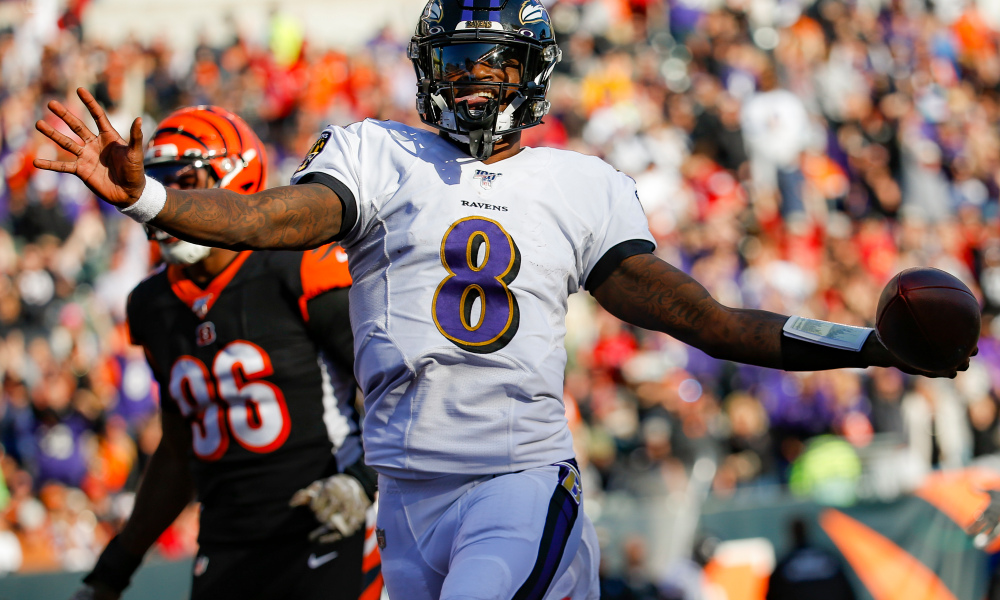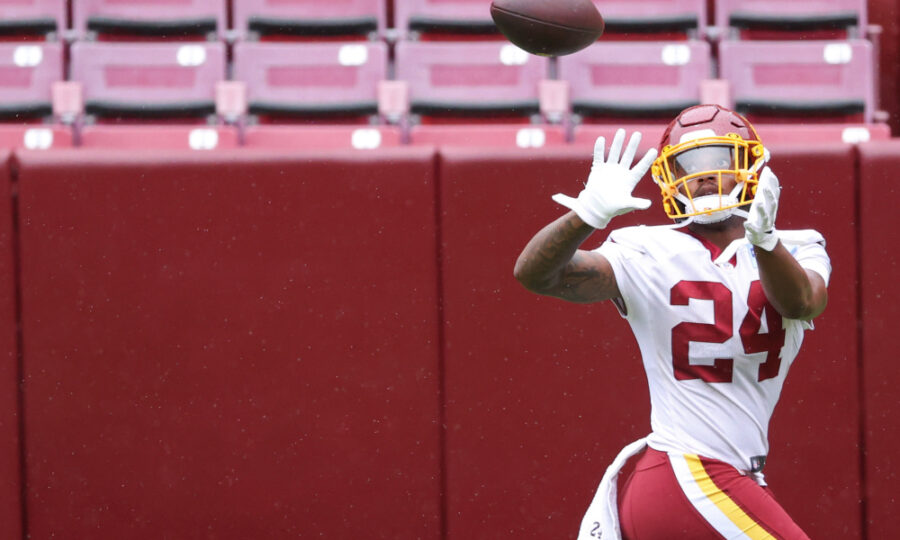NFL Game Scripts Week 4: Baltimore Ravens @ Washington Football Team
While the DMV derby only happens once every four years, it comes at a time where both the Baltimore Ravens and Washington Football Team are looking to bounce back from Week 3 losses and return to the top of their divisions. Washington’s offense has been inconsistent this season, while their front seven on defense are among the best in the league. Baltimore’s offense was free flowing in Weeks 1-2, but struggled in Week 3, with the defense unable to bail them out. This matchup seems like a good bounce-back game for the Ravens, while Washington try to sort out their own issues.
Baltimore Offense vs Washington Defence
The Run Game

With the league’s best rushing attack in 2019, the Ravens haven’t hit the same historic pace in 2020. With Mark Ingram as their lead RB, Baltimore are still working in runs for JK Dobbins and Gus Edwards, while also allowing QB Lamar Jackson to keep the ball at times. Jackson’s read-option abilities are what makes Baltimore so effective rushing the football, although there may be less of that in this game. The stout DL of Washington will force Jackson to rush to the outside more, where he is less likely to keep the ball and run up the middle. Although the first half will see fewer Jackson runs, if Baltimore bullds a lead by halftime, they will use more of these in the third quarter to put the game away.
In addition to Jackson posing a threat as a runner, Baltimore’s rushing attack works because of the number of moving pieces and deception they can use. With Jackson already forcing a defender, usually a LB, to commit to guarding the edge in an attempt to contain the QB. The Ravens can also move pieces around to open up holes across the field. FB Patrick Ricard is regularly used as a lead blocker for inside and outside zone runs, but simultaneously is used to trick opponents into following him to the outside while the RB stays inside or runs a counter concept. At times, Baltimore does this with their OL as well, having them (and TEs or FB) run in one direction, and the RB able to choose to either follow if the defense doesn’t shift with them, or change direction if the defense follows to the outside.
To further add to their rushing attack, Baltimore also uses extra blockers in a power scheme at times. Ricard and TEs Nick Boyle and Mark Andrews can be lined up together or on opposite sides of the line so that defenses are forced to show what alignment they are in. With split TEs the Ravens generally run read-option plays or use 2 RB formations, allowing them to choose which side of the defense they attack. At other times, pulling an OG to get to the outside further sets up Ingram, Dobbins or Jackson with rushing lanes, while Edward usually runs between the Tackles.
Ingram and Dobbins are both used for the full breadth of the Ravens’ run and pass plays, making it hard for opponents to force them into the inside or outside. Early in the game the Ravens will use Ingram and Dobbins on runs to the inside and outside, and during the second quarter introduce Edwards as a power rusher inside of the OTs. As the first half progresses, the Ravens will start to use Dobbins more on outside runs, with Ingram remaining in use for read-option plays. This then sets up inside and outside runs for Ingram in the second half as Washington focuses on Jackson more, while Dobbins can also be used on 2RB formations with fake handoffs to either him or Ingram.
Washington will be relying on their DL winning matchups on the edge so that they can play a contain defense. While they may choose to continue pressuring Jackson, if they can’t get close to him and he escapes for big plays on the outside, they will back off from this a little. Additionally, containment on the edge allows them to funnel more runs up the middle, where LBs Jon Bostic, Kevin Pierre-Louis, Shaun Dion Hamilton and Thomas Davis can be waiting. Pierre-Louis in particular could be tasked with matching up with Ingram and Dobbins, so that if they are sent to the outside he can cover them there. Using Safeties Landon Collins and Troy Apke as well in the box to defend the option plays will frustrate the Ravens. Washington’s aim will be limiting the Ravens from having success rushing the football, so that third down becomes passing downs, which is part of what Chiefs did in Week 3 to beat Baltimore.
The Passing Game
Baltimore will want to expand their passing game after its limited success in Week 3, and have the third-fewest passing yards so far this season. They typically only have two WRs on the field to allow for their rushing attack with its extra blockers, but this doesn’t allow them to scheme open Marquise Brown easily. Brown’s role is generally as the deep threat, where he runs down the numbers, using double moves to get separation, or crossing routes if opponents are in Cover 1.
With Brown usually drawing the extra attention on passing downs, WRs Willie Snead, Devin Durvernay and Miles Boykin are usually sent on short and intermediate routes over the middle, or sometimes on screens. Increasing their use of 3WR sets against Washington, especially in the first half, should give Baltimore more chance to get Brown open, or if he is facing double coverage, the second and third receiver can be targeted on underneath throws. The Ravens will target Brown deep early on in the game, but should consider sending Duvernay on downfield routes a few times instead, and getting Brown free on slants and screens more often. By the second half, if Jackson can’t find Brown deep, they may use him with levels concepts more, so that Snead or another WR is free underneath instead.
The other components of the Ravens passing attack are the TEs and RBs. The RBs are used often on screens, with Snead especially providing an extra blocker on the outside. At other times, the RBs are used on swing routes to the outside, sitting in space created by Brown running downfield. The TEs, however, work the middle of the field on intermediate routes, with hitches, slants and in routes all used to positioned themselves between the defender and Jackson for clearer passing lanes. TE Mark Andrews is sometimes sent a little deeper and Jackson targets him above defenders, but it is dependent on who is covering him. In the red zone, Andrews is used on slants to the outside, or late release plays where he runs curls or out routes.
The first half should see Andrews targeted a few times on fade routes, with Brown or Snead crossing underneath, forcing the Washington LBs to commit to covering one of them, freeing up either a WR for a 5-10yd gain, or giving Jackson a shot deeper to Andrews. As the first half continues, Andrews may see shorter routes over the middle, with increased RB screens as well, opening up bubble screens and deep post routes for Brown and the WRs.
Washington will have to commit to stopping the run, even if it means exposing themselves on deep passes. Safety Apke will mostly be used in coverage over the top, with Collins in the box to attack the run and cover Andrews. The LBs should be used with zones to cover the middle of the field, while also watching the outside for RB releases.
The pass rush could be negated by screens, yet Washington have the luxury of not needing to blitz often, as their DL can be a sufficient pass rush in most cases. DEs Montez Sweat, Ryan Kerrigan and Chase Young if he’s healthy, along with DTs Daron Payne and Jonathan Allen will need to flush Jackson from the pocket and quickly pursue to the outside if they can’t bring him down, while Collins or a LB is also ready to get to the outside to prevent Jackson from escaping upfield. Although they have to risk big plays downfield, taking away the short field deception and forcing Jackson to throw deep gives Washington their best chance of success.
What should we expect to see on Sunday?
Baltimore will be a little more balanced than usual in the first half so that they can build up a lead. Their moving pieces in the run game will be used in the passing game, although a few additional 3WR sets will be used, mostly to scheme Marquise Brown open. The Ravens won’t have designed runs for Jackson as much in this game, and will use screens to negate Washington’s pass rush. Washington should be prepared to allow deep passing plays as they play contain on defense, taking away running lanes for Jackson and the RBs, using both Safeties and the LBs to defend the space between the OL and sideline. Baltimore’s deception in the run game could allow them to get players into the second level, and once this happens, they should have more space downfield for Andrews and Brown.
Washington Offense vs Baltimore Defense
The Run Game

Washington are slowly transitioning to using RB Antonio Gibson as their lead back, although he is rotating snaps with JD McKissic currently, while Peyton Barber gets goal line work. Both Gibson and McKissic are used in the passing game as well, although Washington have yet to figure out how best to use them. Currently they run both up the middle and to the outside, but not with a strategic approach.
The outside runs are usually on toss plays to get the extra distance to the outside, so that McKissic and Gibson can run in space, using their agility to get past DBs and LBs. Handoffs up the middle on inside zone plays also expect both RBs to cutback and find holes, and Washington will vary both inside and outside runs throughout the game. They may choose to start using both RBs on the field at the same time into the second and third quarters, with Gibson especially suited to splitting out wide in a receiving role.
2RB formations will also allow Washington to use more fake handoffs and split zone concepts to further disguise their run plays. Washington must continue varying the direction of their runs to prevent Baltimore stacking the box in a certain way, and this will allow them to continue running the ball in the second half.
Although they have been mediocre against the run in terms of yards and yards per carry, Baltimore have only allowed one rushing TD this season. They will defend the run with their usual 3-4 defense, with NT Brandon Williams lined up over Center and closing the A-gaps as he reacts to run plays. LBs LJ Fort and Patrick Queen will be lined up over the OGs to further cover the inside gaps, and Safety DeShon Elliott closer to the line of scrimmage to guard the edge. Washington could find space on the outside with their toss plays, but need to also get to the second level, where they can test the rookie Queen.
The Passing Game
Washington has a similar lack of imagination in the passing game currently. WR Terry McLaurin is the focus of their offense, but is often not schemed open, nor is used to take attention off others. Fellow WRs Dontrell Inman and Isaiah Wright have started to get extra targets over the last two weeks, but Washington is yet to develop plays building around the skillsets of these three.
In Week 3 they began to increasingly use bunch formations, but need to expand on this more. Earlier in the game, Washington will use crossing routes, with their third WR running up the outside on curl, fade and post routes. Into the second quarter, there will be more bunch formations, with Washington able to then send Inman over the middle, Wright up the seam, with McLaurin then also on an in or slant route further up field. In the second half, McLaurin needs to begin with slants, but then have out routes to shed coverage, while Wright and Inman can run the other routes as part of dagger concepts.
Moreover, as the game progresses Washington also needs to use their RBs and TE Logan Thomas more in the passing game. WR screens from a bunch formation can be used into the second quarter, with RB screens subsequently used to get McKissic or Gibson in space with blockers. Thomas primarily is used on short out and slant routes, and occasionally hitch routes. Further to this, once all weapons have been used in the passing game, Washington needs to use play action to further get players open and give QB Dwayne Haskins clear throwing lanes. With Haskins on bootleg and rollouts, it allows Thomas, McLaurin and Wright to run the same direction, giving Haskins reads downfield. Into the second half, it also can be used to set up the RBs on screens, and will buy the WRs time to get open downfield.
Baltimore’s CBs are strong in man coverage, with Marlon Humphrey likely to follow McLaurin most of the game, Marcus Peters taking the outside receiver, and Jimmy Smith covering the slot. With the WRs facing tight coverage, it will make it harder for Haskins to complete passes, forcing them to turn to the TEs and RBs more. The Ravens will be reluctant to use Queen in coverage again after he struggled against the Chiefs in Week 3, and also need to generate a pass rush, without having to blitz as heavily as they normally do.
With Queen potentially shooting the gap in the middle, LJ Fort will instead be asked to track the RBs, leaving the Ravens in Cover 1 for much of the game. They may adjust into the second half to use more zone defenses, to further help generate pressure on Haskins, but if they build a lead early will be happy to continue giving small gains if it means they retain the lead.
What should we expect to see on Sunday?
Washington needs to scheme their WRs open more, with greater versatility of passing concepts. Using levels, daggers, screens and PA at times to give Haskins easier reads. Integrating the RBs early in the game as receivers will free up McLaurin downfield, and in turn ease up the defensive pressure at the line of scrimmage for the run. Washington needs to run with a more focused plan from the start, trying to disguise inside runs, while also getting McKissic and Gibson to the outside on more than just toss plays. Baltimore will be happy to play man coverage and restrict inside runs, hoping they can pressure Haskins often and throw off his timing. The Ravens could choose to adjust their secondary into Cover 4 at times, but unless they are in a shootout, will be happy with their usual 3-4 and nickel man cover formations.

